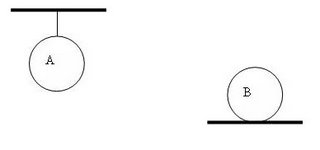
I was just going through a few IPhO papers, solely out of nostalgia; to remember the JEE days when challenges were thrown at us from all directions. I used to, and continue to maintain that Olympiads are one of the very few exams which test the real skill of a person in a particular subject, and one of the very few exams where coaching might come a cropper. For instance, here's a problem from the first International Physics Olympiad, 1967, held at Warsaw, Poland. Some of you might have seen it, others give it a try. A beauty.
Consider two balls, identical in all respects, at the same initial temperatures. One of them is at rest on a horizontal plane, the other hangs from a thread (as shown). The same quantity of heat is supplied to both. Will the final temperatures of both the balls be the same?
Think think! The answer is below, but give it your best try before looking at the solution.
Think think!
Think think!
Don't give up!
Harder!

The solution is exceedingly simple! The balls expand as shown. The center of mass of A goes down, while that of B moves up. Thus, some amount of heat is utilized in B to do work against gravity. So lesser temperature rise! Tell me, can it get simpler and better?
Oh, and if you even have the slightest feeling that IPhO problems are simple, you can try a 50 marker from one of the IPhOs :
Somewhere in a glass sphere there is an air bubble. Determine mathematically the radius of the air bubble, using any method you want, without damaging the glass sphere. [50]
11 comments:
What was the time when you made this post?
Whoa, when did you post so much ??? Bloglines didn't seem to catch it at all!
Anon:
3AM
yeah da... in such an isolated general system a little 'out of box' energy fundae thinkig will get u the answer...:)..
nice one.. hey wanted to discuss that
sphere problem though.. and have u seen the latest ipho papers .. i saw last years.
I got the 50 marker.... :)
maga cud you send me the link to the solutions ?
NO link da
I have soft copies on my comp.
Hi there
What does everyone think of what is going on in Iraq?
Wow, I've found the same to be true too! How did you find that?
See you soon! Girly Girl
[color=#69c][url=http://paid-opinion-surveyhkzlpx.blogspot.com]how I make money with paid surveys[/url][/color]
If conductivity of air is lesser than the surface that B rests on, wont the loss of heat also count?
Besides, A possesses potential energy whereas B possesses neither potential/kinetic energy. So I thought it had to be A!
:(
-An IIT aspirant reading IITians' blogs to derive (much needed) inspiration! :)
Anon:
Why dont you drop me a mail at
karthik.cb@gmail.com
Would be glad to help you out if anything required.
Also, Anon
Both your points are wrong.
1. Conductivity doesn't come in, as the area of contact with air is the same in both cases. Area of contact with the ground = Zero.
2. Potential energy which is there in the first ball, will be RETAINED.
Post a Comment